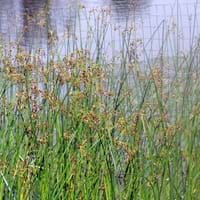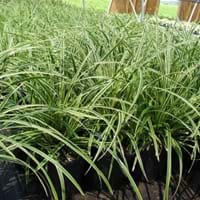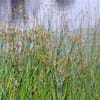Life Span
Perennial
Perennial
Type
Sedge or Rush
Sedge or Rush
Origin
North America
Japan
Types
Not Available
Not Available
Habitat
Lake margins, Lake Sides, Lakes
Lawn, shaded fields, Shaded sites
USDA Hardiness Zone
Not Available
5-9
AHS Heat Zone
Not Available
9-5
Sunset Zone
Not Available
3a, 3b, 4, 5, 6, 7, 8, 9, 14, 15, 16, 17, 18, 19, 20, 21, 22, 23, 24
Habit
Upright/Erect
Clump-Forming
Minimum Height
Not Available
Minimum Width
Not Available
Flower Color
Not Available
Tan
Flower Color Modifier
Bicolor
Bicolor
Fruit Color
Not Available
Non Fruiting Plant
Leaf Color in Spring
Olive
Green, Light Yellow
Leaf Color in Summer
Olive
Green, Light Yellow
Leaf Color in Fall
Olive
Green, Light Yellow
Leaf Color in Winter
Sandy Brown
Tan
Leaf Shape
Long linear and narrow
Long Narrow
Plant Season
Spring, Summer, Fall
Spring, Summer, Fall, Winter
Sunlight
Full Sun
Partial shade, Full Shade
Growth Rate
Medium
Medium
Type of Soil
Clay, Loam, Sand
Clay, Loam
The pH of Soil
Acidic, Neutral, Alkaline
Acidic, Neutral
Soil Drainage
Poorly Drained
Well drained
Bloom Time
Not Available
Early Summer, Summer
Tolerances
Drought
Drought
Where to Plant?
Container, Ground
Container, Ground, Pot
How to Plant?
Rhizome division, Seedlings
Divison, Seedlings
Plant Maintenance
Medium
Medium
Watering Requirements
occasional watering once established
Average Water Needs
In Summer
Lots of watering
Lots of watering
In Spring
Moderate
Moderate
In Winter
Average Water
Average Water
Soil pH
Acidic, Neutral, Alkaline
Acidic, Neutral
Soil Type
Clay, Loam, Sand
Clay, Loam
Soil Drainage Capacity
Poorly Drained
Well drained
Sun Exposure
Full Sun
Partial shade, Full Shade
Pruning
Remove damaged leaves, Remove dead branches, Remove dead leaves
Remove damaged leaves, Remove dead branches, Remove dead leaves
Fertilizers
All-Purpose Liquid Fertilizer
All-Purpose Liquid Fertilizer
Pests and Diseases
Aphids, Mealy bugs, Scale, Scale insects
Red blotch
Plant Tolerance
Drought
Drought
Flowers
Insignificant
Insignificant
Flower Petal Number
Single
Single
Foliage Texture
Bold
Fine
Foliage Sheen
Glossy
Glossy
Attracts
Birds, Butterflies
Bees
Allergy
Itchiness
Itchiness
Aesthetic Uses
Showy Purposes
Showy Purposes
Beauty Benefits
Not Available
Not Available
Environmental Uses
Air purification
Air purification
Medicinal Uses
Abscess, Snakebite, Wounds
Not Available
Part of Plant Used
Rhizomes, Root, Seeds, Shoots, Stem
Not Available
Other Uses
Used As Food
Not Available
Used As Indoor Plant
No
No
Used As Outdoor Plant
Yes
Yes
Garden Design
Bog Garden, Water Gardens
Container, Edging, Groundcover, Mixed Border, Rock Garden / Wall
Botanical Name
Schoenoplectus Tabernaemontani
Carex Morrowii
Common Name
Grey Club-Rush, Great Bulrush, Softstem Bulrush
Japanese Sedge, Carex Grass Evergold
In Hindi
Softstem Bulrush
Carex Grass Evergold
In German
Softstem Bulrush
Carex Grass Evergold
In French
Softstem Bulrush
Carex Grass Evergold
In Spanish
Softstem Bulrush
Carex Grass Evergold
In Greek
Softstem Bulrush
Carex Grass Evergold
In Portuguese
Softstem Bulrush
Carex Grass Evergold
In Polish
Softstem Bulrush
Carex Grass Evergold
In Latin
Softstem Bulrush
Carex Grass Evergold
Phylum
Magnoliophyta
Tracheophyta
Class
Liliopsida
Magnoliopsida
Family
Cyperaceae
Cyperaceae
Genus
Schoenoplectus
Carex
Clade
Angiosperms, Commelinids, Monocots
Angiosperms, Commelinids, Monocots
Tribe
Not Available
Not Available
Subfamily
Not Available
Not Available
Properties of Softstem Bulrush and Carex Grass Evergold
Wondering what are the properties of Softstem Bulrush and Carex Grass Evergold? We provide you with everything About Softstem Bulrush and Carex Grass Evergold. Softstem Bulrush doesn't have thorns and Carex Grass Evergold doesn't have thorns. Also Softstem Bulrush does not have fragrant flowers. Softstem Bulrush has allergic reactions like Itchiness and Carex Grass Evergold has allergic reactions like Itchiness. Compare all the properties and characteristics of these two plants. Find out which of these plant can be used as indoor plant. If you are interested to decorate your house and garden, find out aesthetic uses, compare them and select the plant which will beautify your surrounding. Along with beautification, try comparing medicinal and edible uses of Softstem Bulrush and Carex Grass Evergold and you can choose the plant having best and most benefits.
Season and Care of Softstem Bulrush and Carex Grass Evergold
Season and care of Softstem Bulrush and Carex Grass Evergold is important to know. While considering everything about Softstem Bulrush and Carex Grass Evergold Care, growing season is an essential factor. Softstem Bulrush season is Spring, Summer and Fall and Carex Grass Evergold season is Spring, Summer and Fall. The type of soil for Softstem Bulrush is Clay, Loam, Sand and for Carex Grass Evergold is Clay, Loam while the PH of soil for Softstem Bulrush is Acidic, Neutral, Alkaline and for Carex Grass Evergold is Acidic, Neutral.
Softstem Bulrush and Carex Grass Evergold Physical Information
Softstem Bulrush and Carex Grass Evergold physical information is very important for comparison. Softstem Bulrush height is 270.00 cm and width 150.00 cm whereas Carex Grass Evergold height is Not Available and width Not Available. The color specification of Softstem Bulrush and Carex Grass Evergold are as follows:
Softstem Bulrush flower color: Not Available
Softstem Bulrush leaf color: Olive
Carex Grass Evergold flower color: Tan
- Carex Grass Evergold leaf color: Green and Light Yellow
Care of Softstem Bulrush and Carex Grass Evergold
Care of Softstem Bulrush and Carex Grass Evergold include pruning, fertilizers, watering etc. Softstem Bulrush pruning is done Remove damaged leaves, Remove dead branches and Remove dead leaves and Carex Grass Evergold pruning is done Remove damaged leaves, Remove dead branches and Remove dead leaves. In summer Softstem Bulrush needs Lots of watering and in winter, it needs Average Water. Whereas, in summer Carex Grass Evergold needs Lots of watering and in winter, it needs Average Water.





